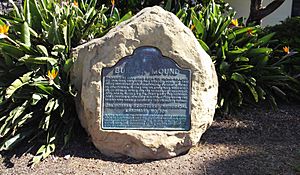Syuxtun Village facts for kids
Quick facts for kids Syuxtun Village |
|
|---|---|
| Ambassador Park | |
| Lua error in Module:Location_map at line 420: attempt to index field 'wikibase' (a nil value). | |
| Location | 100 West Cabrillo Blvd, Santa Barbara, CA |
| Owned by | City of Santa Barbara |

California Historical Landmark Plaque in Ambassador Park
|
|
| Location | Ambassador Park, Santa Barbara, California |
| Official name: Burton Mound | |
| Designated | July 12, 1939 |
| Reference no. | 306 |
Syuxtun (also called Syujtun) was once a large village of the Chumash people. It was located in what is now Santa Barbara, California, in the United States. Today, this important place is known as Burton Mound. It is a special California Historical Landmark and is managed by the city as Ambassador Park.
European explorers first found this Native American village in 1542. Juan Rodríguez Cabrillo was one of the first to visit. Later, Juan Crespí and Gaspar de Portolà also explored and wrote about the village. The California Department of Parks and Recreation says that Burton Mound has given us "some of the most important archaeological evidence found in California." This means many valuable clues about the past have been discovered here.
Contents
A Look Back: Syuxtun's History
In 1782, Syuxtun was one of the biggest Chumash villages along the South Coast. Gaspar de Portolà visited the village around August 1769. His group said it was the largest village they had seen so far. They estimated that at least 600 people lived there. One person in Portolà's group wrote that they had never met people so kind and friendly.
Changes Over Time
By the early 1830s, the entire village of Syuxtun had disappeared. Around 1800, about 120 people still lived there. Many Chumash people sadly passed away from illnesses brought by the Spanish. Others became part of Mission Santa Barbara.
A large building was built on the site to store animal hides. In 1833, Joseph John Chapman bought the property. He had helped build Mission San Gabriel Arcángel.
Burton Mound's New Name
In 1860, Lewis T. Burton bought the property. The area was later named "Burton Mound" after him. Lewis Burton was a well-known hunter and trapper. He hunted otters in the Santa Barbara Channel. Their skins were very valuable.
Burton became an important person in Santa Barbara. He started many businesses, including a post office and a general store. He also had orchards. He passed away in 1879.
From Hotel to Park
In January 1903, the property became part of the Potter Hotel. This was a fancy hotel with 600 rooms. In April 1921, the hotel, then called the Ambassador, was destroyed by a fire. It was never rebuilt.
After the fire, the site became very interesting to archaeologists. These are scientists who study the past by digging up old objects. John P. Harrington led an excavation for the Smithsonian Institution. He started digging in the spring of 1923. By the end of that summer, over 2,500 objects were found! These objects are now kept at the National Museum of the American Indian.
In 1924, the path to the former hotel was given to the city. On July 12, 1939, the site within Ambassador Park was officially named a California Historical Landmark.
The Sulfur Spring
Long ago, there was a natural sulfur spring at Burton Mound. It was located between Chapala and Bath Streets, close to the old Joseph Chapman home.
Burton Mound Today
Today, the Burton Mound site is near West Beach. The area around it has many shops and homes. It remains a special place that helps us remember the Chumash people and their history.

